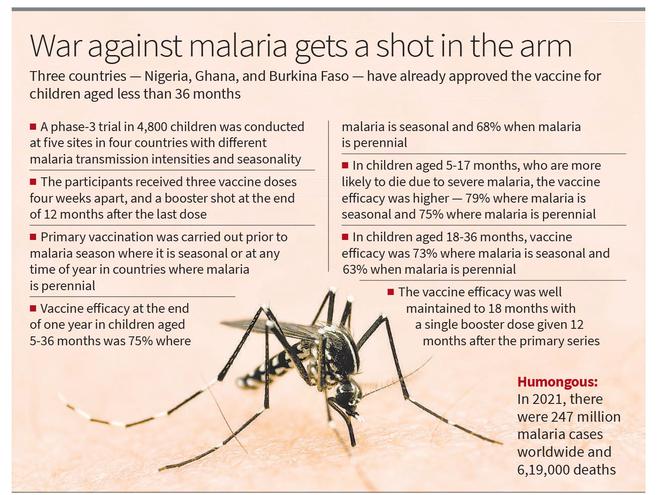A malaria vaccine — R21/MatrixM — developed by the University of Oxford, manufactured by the Pune-based Serum Institute of India and tested in a phase-3 trial at five sites in four countries — Mali, Burkina Faso, Kenya, and Tanzania — in Africa was recommended (but yet to be prequalified) by the WHO on October 2.
Three countries — Nigeria, Ghana, and Burkina Faso — have already approved the use of the vaccine to immunise children aged less than 36 months. According to the WHO, in 2021, there were 247 million malaria cases worldwide and 6,19,000 deaths. About 25 million children are born each year in countries with moderate to high malaria transmission.
The phase-3 trial was conducted in 4,800 children who were randomly assigned to receive either the malaria vaccine or a control (approved rabies vaccine) and neither the participants nor the people conducting the trial knew who got the vaccine and who did not. The five sites in the four countries where the trial was conducted have different malaria transmission intensities and seasonality. The participants received three vaccine doses four weeks apart, and a booster shot at the end of 12 months after the last dose. The primary vaccination was carried out prior to the malaria season in countries where malaria is seasonal or at any time of year in countries where malaria occurs throughout the year.

As per the results of the phase-3 trial that have been posted in a preprint server (preprints are yet to be peer-reviewed), the vaccine efficacy at the end of one year in children aged 5-36 months was 75% where malaria is seasonal and 68% where malaria is perennial. In children aged 5-17 months, who are more likely to die due to severe malaria, the vaccine efficacy was higher — 79% where malaria is seasonal and 75% where malaria is perennial. In children aged 18-36 months, vaccine efficacy was 73% where malaria is seasonal and 63% where malaria is perennial. “The vaccine efficacy was well maintained to 18 months with a single booster dose given 12 months after the primary series,” authors of the preprint write.
“Our findings are consistent with data from a recently completed phase IIb trial at the Nanoro seasonal site, where vaccine efficacy was 76% and 77% over one and two years of follow-up using a four dose (primary plus booster) vaccine regime in 5-17-month-old infants,” they note.
The higher vaccine efficacy in younger children (5-17 months) compared with older children (18-36 months) might be a “sign that the vaccine is less effective in people who have already been exposed to malaria” Matthew Laurens, a malaria vaccine expert at the University of Maryland School of Medicine told Science. And if that turns out to be true, then the vaccine might have “lower efficacy in areas with very high malaria incidence, where young infants are exposed at an early age”.
Waning efficacy
“There was some waning of efficacy over the first year of follow-up at both seasonal and perennial transmission sites, but a booster dose restored efficacy at the seasonal sites with a vaccine efficacy over 18 months of 74%,” says an Oxford University release.
The vaccine efficacy of R21/MatrixM is much higher than the first malaria vaccine — RTS,S/AS01 that has been recommended by the WHO in 2021 — which had a vaccine efficacy of 56% at the end of one year in children aged 5-17 months. According to the preprint, even after four booster shots of the RTS,S/AS01 vaccine, the efficacy was only 58% over five years.
The results indicate that the vaccine was more efficacious in places where malaria was seasonal than when it was perennial. The authors think that this may partly be due to timing of malaria episodes in countries with seasonal or perennial malaria. The study found that in sites where malaria was seasonal, 82% of malaria episodes in the first year were recorded in the first six months of follow-up, while only 26% of malaria episodes over the first year were recorded in the first six months at the sites where malaria is perennial. The vaccine efficacy is highest 14 days after the third dose and begins to slowly wane. Since the vaccination is carried out just before the beginning of the malaria season, the protection offered is higher when the disease is seasonal than when malaria occurs throughout the year.
The authors claim that besides substantially reducing the number of clinical malaria cases, at 12 and 18 months, there was “significantly reduced” parasite load in children who received the vaccine (R21/Matrix-M). This suggests that the vaccine may help reduce malaria transmission, especially when combined with other strategies such as mosquito nets.
According to the WHO, the cost of the R21/Matrix-M manufactured by Serum Institute will be between $2 and $4 per dose. Serum Institute will produce “over 100 million doses a year”.







